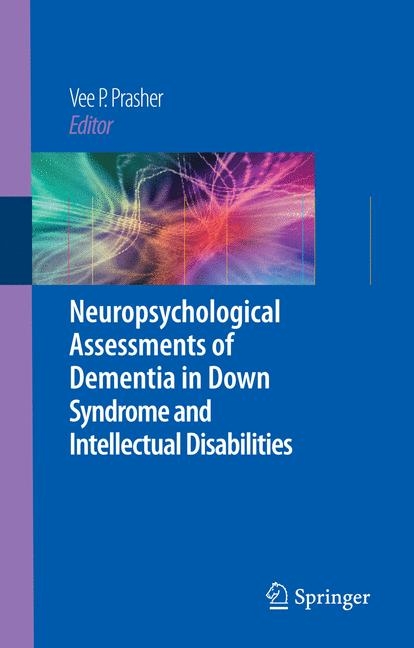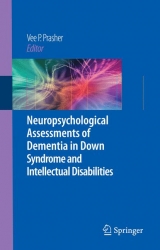Neuropsychological Assessments of Dementia in Down Syndrome and Intellectual Disabilities
Seiten
2008
Springer London Ltd (Verlag)
978-1-84800-248-7 (ISBN)
Springer London Ltd (Verlag)
978-1-84800-248-7 (ISBN)
- Titel erscheint in neuer Auflage
- Artikel merken
Zu diesem Artikel existiert eine Nachauflage
This book reviews important neuropsychological measures currently used in the assessment of dementia by the principal clinicians and researchers associated with the test, offering practical guidance on each test along with an analysis of its limitations.
Up to the early 1980s neuropsychological assessments of persons with intellectual disability (ID) usually meant an assessment for developmental delay, of intelligence (intelligence quotient testing) or of level of adaptive behavior. Popular tests included the Stanford-Binet, Wechsler Intelligence Scales, Bayley Scales of Infant Development, the Griffin Mental Developmental Scales, and the Vineland Social Maturity Scale. These were assessments of the "overall" level of ability. Arthur Dalton in New York was one of a few pioneering clinicians who at this time, focused on the development of tests for specific areas of cognition in persons with ID. Following his work, sub- quent researchers, in the latter part of the twentieth century, have proposed and dev- oped a number of measures not only to detect the level of cognitive abilities but also to measure decline; a perquisite to the diagnosis of dementia. At the beginning of the twenty-first century as demonstrated in this book, several neuropsychological measures have been developed to aid the clinical diagnosis of dementia/dementia in Alzheimer's disease (AD).
Neuropsychological assessments no longer remain the sole responsibility of psychologists, as psychiatrists, resear- ers, ID nurses, neuroscientists, all now play a part in the development and adm- istration of specific tests.
Up to the early 1980s neuropsychological assessments of persons with intellectual disability (ID) usually meant an assessment for developmental delay, of intelligence (intelligence quotient testing) or of level of adaptive behavior. Popular tests included the Stanford-Binet, Wechsler Intelligence Scales, Bayley Scales of Infant Development, the Griffin Mental Developmental Scales, and the Vineland Social Maturity Scale. These were assessments of the "overall" level of ability. Arthur Dalton in New York was one of a few pioneering clinicians who at this time, focused on the development of tests for specific areas of cognition in persons with ID. Following his work, sub- quent researchers, in the latter part of the twentieth century, have proposed and dev- oped a number of measures not only to detect the level of cognitive abilities but also to measure decline; a perquisite to the diagnosis of dementia. At the beginning of the twenty-first century as demonstrated in this book, several neuropsychological measures have been developed to aid the clinical diagnosis of dementia/dementia in Alzheimer's disease (AD).
Neuropsychological assessments no longer remain the sole responsibility of psychologists, as psychiatrists, resear- ers, ID nurses, neuroscientists, all now play a part in the development and adm- istration of specific tests.
Overview of the neuropsychological assessment of dementia in intellectual disability.- Issues in Dementia Assessment Methods.- The Dementia Questionnaire for People with Intellectual Disabilities.- Dementia Scale for Down Syndrome.- The Dyspraxia Scale for adults with Down syndrome.- Adaptive Behavior Change and Dementia in Down Syndrome: Case Classification Using the Adaptive Behavior Scale.- The Cambridge Examination for Mental Disorders of Older People with Down’s Syndrome and Others with Intellectual Disabilities (CAMDEX-DS).- The Test for Severe Impairment.- The Cued Recall Test: Detection of Memory Impairment.- The Adaptive Behavior Dementia Questionnaire (ABDQ).- Strengths of Previous Work and Future Challenges.
| Erscheint lt. Verlag | 29.12.2008 |
|---|---|
| Zusatzinfo | 31 Tables, black and white; 42 Illustrations, black and white; X, 232 p. 42 illus. |
| Verlagsort | England |
| Sprache | englisch |
| Maße | 155 x 235 mm |
| Gewicht | 373 g |
| Themenwelt | Medizin / Pharmazie ► Medizinische Fachgebiete ► Geriatrie |
| Medizin / Pharmazie ► Medizinische Fachgebiete ► Neurologie | |
| ISBN-10 | 1-84800-248-3 / 1848002483 |
| ISBN-13 | 978-1-84800-248-7 / 9781848002487 |
| Zustand | Neuware |
| Haben Sie eine Frage zum Produkt? |
Mehr entdecken
aus dem Bereich
aus dem Bereich
Das Wichtigste für Ärztinnen und Ärzte aller Fachrichtungen
Buch | Softcover (2021)
Urban & Fischer in Elsevier (Verlag)
37,00 €
Zukunftssicherheit der Geriatrie - Konzept und Bedarfszahlen
Buch | Softcover (2023)
Kohlhammer (Verlag)
36,00 €





